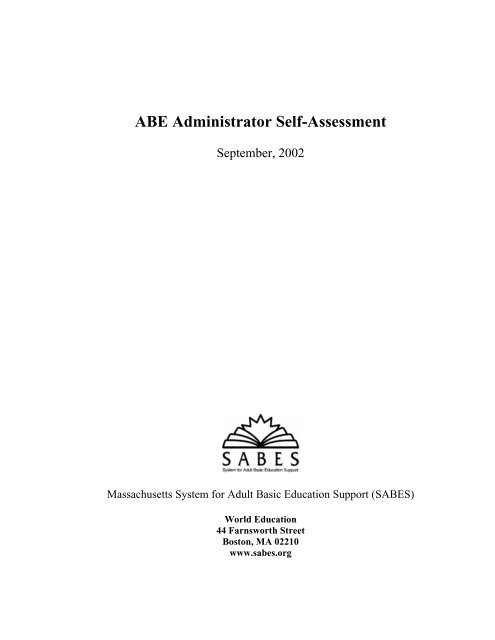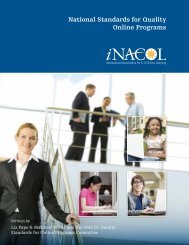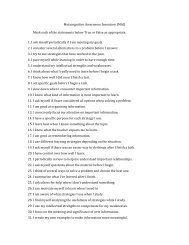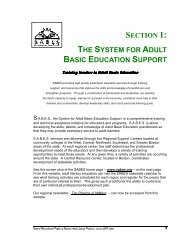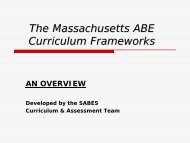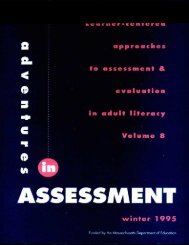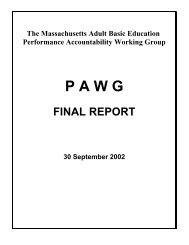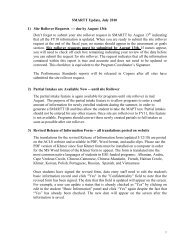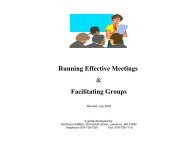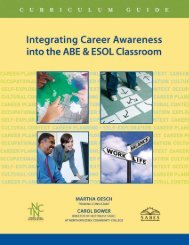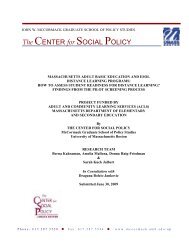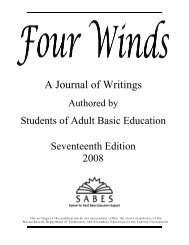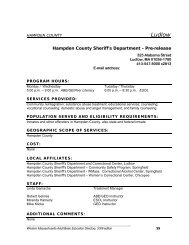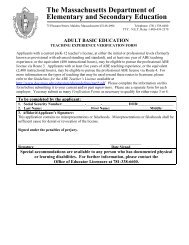ABE Administrator Self-Assessment Survey - SABES
ABE Administrator Self-Assessment Survey - SABES
ABE Administrator Self-Assessment Survey - SABES
You also want an ePaper? Increase the reach of your titles
YUMPU automatically turns print PDFs into web optimized ePapers that Google loves.
<strong>ABE</strong> <strong>Administrator</strong> <strong>Self</strong>-<strong>Assessment</strong><br />
September, 2002<br />
Massachusetts System for Adult Basic Education Support (S<strong>ABE</strong>S)<br />
World Education<br />
44 Farnsworth Street<br />
Boston, MA 02210<br />
www.sabes.org
<strong>ABE</strong> <strong>Administrator</strong> <strong>Self</strong>-<strong>Assessment</strong><br />
Purpose:<br />
• Identify strengths and areas for improvement<br />
• Become aware of competencies you may not have considered<br />
• Plan your professional development-- set goals based on areas needing improvement<br />
• Consider mentoring other directors in areas where you are most skilled<br />
• Help S<strong>ABE</strong>S identify areas for training<br />
Instructions:<br />
1. Read the management competencies below. Each is followed by some sample indicators to<br />
help you determine whether you are effectively performing that competency.<br />
2. Fill out the Information Form. Please make sure to fill out your name and contact<br />
information if you would like S<strong>ABE</strong>S to contact you to either (1) offer help on a<br />
competency which you have rated as novice or basic or (2) give you an opportunity to<br />
provide support for another director on a specific competency on which you have rated<br />
yourself as an expert. The latter may involve availability by phone or e-mail to advise<br />
another director, participating in a sharing group or roundtable, or leading a workshop in a<br />
S<strong>ABE</strong>S region.<br />
3. Depending on how much time you have and how much detail you want to consider, you can<br />
choose to use either the short form or the long form of this assessment. Or you may find it<br />
useful to use both, the short form for the overall picture and the long form for the specifics.<br />
A. Short form:<br />
Circle a number on the short form chart next to each management competency. Choose 4 if<br />
you believe you are very strong, 3 if you believe you are performing well, 2 if you have<br />
some basic skills in that area, and 1 if you need help developing that competency.<br />
B. Long form:<br />
Circle a number on the long form chart next to each indicator. Choose 4 if you believe you<br />
are very strong, 3 if you believe you are performing well, 2 if you have some basic skills in<br />
that area, and 1 if you need help developing that competency. If a particular competency<br />
does not apply to your situation, put NA in the comments box.<br />
4. On the Learning Methods and Goals Sheet, check off your preferred methods of learning.<br />
5. On the Learning Methods and Goals Sheet, set staff development goals and outline steps to<br />
reach those goals<br />
Return the forms to Mina Reddy, S<strong>ABE</strong>S, World Education, 44 Farnsworth Street, Boston, MA<br />
02210<br />
Source:<br />
This material was adapted by S<strong>ABE</strong>S from Management Competencies <strong>Assessment</strong> Instrument, a publication of<br />
Building Professional Development Partnerships for Adult Educators Project (PRO-NET 2000), American<br />
Institutes for Research, sponsored by the U.S. Department of Education.
Management Competencies and Sample Indicators<br />
Communication<br />
Demonstrates effective interpersonal and communication skills<br />
Sample indicators:<br />
a) Seeks input from all levels of staff (and, as appropriate, learners, volunteers, board<br />
members); listens attentively<br />
b) Conveys information fully and clearly<br />
c) Uses a variety of modes of communication<br />
d) Shares information of interest to and affecting stakeholders<br />
e) Encourages and allows opportunity for staff to confer and present issues and problems<br />
affecting instruction and other program-related services<br />
f) Provides clear direction to staff<br />
g) Demonstrates group facilitation skills<br />
Human Resource Management<br />
Recruits, hires, supports, evaluates, and terminates staff based on established criteria<br />
Sample indicators:<br />
a) Ensures that new staff receive a formal orientation<br />
b) Provides written job descriptions, policy manuals, mission statement, and organizational<br />
chart to all staff<br />
c) Provides for a regularly scheduled system of instructor observations and evaluations<br />
d) Provides recognition, guidance and support to staff<br />
e) Establishes and follows written policies and procedures for staff<br />
f) Demonstrates fairness, consistency, and respect for individual differences<br />
g) Recognizes when staff are not performing effectively and follows a clear process leading to<br />
improvement or to termination if necessary<br />
h) Promotes an environment in which linguistic and cultural differences are valued and<br />
appreciated<br />
i) Seeks staff who represent the diversity of the student population<br />
j) Respects and honors diversity in everyday interactions<br />
Professional Development<br />
Plans, promotes, and models lifelong learning practices<br />
Sample indicators:<br />
a) Keeps up to date on research on instructional practices, management, and leadership<br />
b) Engages in a variety of activities that foster own learning, e.g. collegial networking, reading<br />
journals, subscribing to listservs<br />
c) Shares information from own learning with staff<br />
d) Collaboratively designs a staff development program in accordance with program needs;<br />
integrates program and staff development; serves as or works closely with program’s staff<br />
and program development facilitator.
e) Encourages staff to plan their own professional development and engage in a variety of<br />
activities (e.g. inquiry research, workshops, institutes, courses, peer coaching, mentoring);<br />
ensures each staff member has an annual professional development plan.<br />
f) Provides for a system of professional development for staff (funding, scheduling,<br />
opportunities for interaction, substitute teachers)<br />
Educational Leadership<br />
Oversees curriculum design and development, instructional processes and strategies<br />
(based on research in adult learning and development), assessment of student learning,<br />
student retention strategies, and student goal-setting.<br />
Sample indicators:<br />
a) Guides instructional staff in designing and implementing educational curricula that<br />
accommodate adult roles, diverse purposes, learning styles, abilities, and cultures<br />
b) Supports staff in planning instructional programs based on state performance standards,<br />
research on effective practice, community and learner needs, demographics, resources, etc.<br />
c) Establishes structures and processes that allow instructors to work together to improve<br />
teaching and learning<br />
d) Encourages use of resources and curriculum materials that support anti-bias and<br />
multicultural learning<br />
e) Assists instructors in incorporating technology into instructional practices<br />
f) Oversees development and implementation of procedures for initial and ongoing assessment<br />
and class placement of learners<br />
g) Ensures that there are appropriate procedures for assessment of students for special learning<br />
needs and that appropriate programming is provided.<br />
h) Oversees development and implementation of procedures for student goal-setting<br />
Planning and Decision Making<br />
Leads the development and promotion of the program philosophy, goals, and objectives<br />
Sample indicators:<br />
a) Leads the development and implementation of a program mission and vision<br />
b) Leads the process to set program goals and program improvement goals<br />
c) Oversees the process of program planning and implementation of plans<br />
d) Encourages and supports active involvement of staff, learners, board members, and other<br />
stakeholders in decision-making processes<br />
e) Delegates authority and decision-making to appropriate entities and supports their process<br />
and decisions<br />
f) Assists staff and learners with implementing change; supports innovations<br />
g) Promotes the use of data for program planning<br />
h) Remains current on trends, issues, and innovations<br />
i) Involves staff in identification of trends, issues, and innovations<br />
j) Engages in and promotes ethical conduct<br />
k) Ensures compliance with the Americans with Disabilities Act
Data Collection and Analysis<br />
Promotes clear procedures for collecting, documenting, analyzing, and reporting data<br />
Sample indicators:<br />
a) Guides staff in deciding what data to collect based on requirements and program<br />
improvement initiatives<br />
b) Establishes and monitors a process for collecting, documenting, and reporting data in a<br />
timely and accurate way<br />
c) Oversees assessments of community needs to determine service and employment needs and<br />
opportunities<br />
d) Fulfills legal and program requirements for compliance, record keeping, and reporting<br />
e) Maintains appropriate confidentiality of staff and student records<br />
f) Oversees collection of data on student educational and societal outcomes<br />
g) Analyzes and disseminates data to stakeholders in an accessible and timely manner<br />
Program Evaluation<br />
Works with program staff to develop protocols for monitoring and evaluating the<br />
program and promotes use of the data for program improvement and accountability<br />
Sample indicators:<br />
a) Leads the development and implementation of an overall program review process to assess<br />
program strengths and areas for improvement<br />
b) Involves staff, students, and community representatives (including <strong>ABE</strong> Advisory Council)<br />
in program evaluation and subsequent use of evaluation data<br />
c) Uses a variety of methods for program evaluation<br />
Fundraising<br />
Identifies funding sources and applies for funding<br />
Sample indicators:<br />
a) Keeps up to date on potential grants and funding sources, including networking with<br />
individual donors and grantmakers<br />
b) Leads local fundraising efforts as appropriate (e.g. membership, special events)<br />
c) Applies for funding through grants, contracts, and other sources<br />
d) Seeks, develops, and maintains partnerships for collaborative fundraising<br />
e) Is successful in raising funds to create, maintain and expand programs<br />
Financial Management<br />
Effectively manages and allocates the budget<br />
Sample indicators:<br />
a) Ensures that expenditures are allowable and appropriate and that allocated funds are<br />
available throughout the fiscal year<br />
b) Tracks expenditures and submits invoices regularly and in a timely fashion<br />
c) Implements a written budget<br />
d) Allocates funds equitably to programs
e) As appropriate to program/agency, works with board of directors to ensure sound fiscal<br />
management<br />
f) As appropriate to program, engages in an annual audit process<br />
Facilities Management<br />
Effectively manages the facilities<br />
Sample indicators:<br />
a) Ensures safe and adequate facilities<br />
b) Provides adequate equipment and supplies, including adaptations for special needs<br />
Community Collaboration/Community Planning<br />
Builds relationships with various agencies and institutions to mutually enhance the<br />
delivery of services<br />
Sample indicators:<br />
a) Maintains ongoing agency outreach and publicity to promote the program and secure<br />
funding, community expertise, and other resources<br />
b) Establishes partnerships and alliances with businesses, institutions of higher education, local<br />
educational agencies, child care centers, health centers, employment and job training<br />
centers, etc. to expand understanding of adult education, assess needs, enhance program<br />
resources, and improve services for adult learners<br />
c) Participates in a local <strong>ABE</strong> Community Planning Group with broad representation; jointly<br />
develop a strategic plan<br />
Advocacy<br />
Advocates for the development of the field of adult education at national, state, and local<br />
levels<br />
Sample indicators:<br />
a) Disseminates information in the community about the program<br />
b) Participates in professional organizations that advocate for the advancement of adult<br />
education<br />
c) Engages and encourages staff and students to be active advocates for adult education,<br />
including through curricular activities
Position<br />
___ <strong>ABE</strong> Director<br />
___ Program Coordinator<br />
<strong>ABE</strong> <strong>Administrator</strong> <strong>Self</strong>-<strong>Assessment</strong> Information Form<br />
___ Staff and Program Development Coordinator<br />
Agency<br />
___ Community-based organization<br />
___ LEA<br />
___ Community College<br />
___ Municipality<br />
___Corrections<br />
Geographic Area<br />
___ Urban<br />
___ Suburban<br />
___ Rural<br />
Years of Experience as an <strong>ABE</strong> <strong>Administrator</strong><br />
___ 0-1<br />
___ 2-5<br />
___ more than 5<br />
Status<br />
___ Full-time (30+ hours per week or as defined by your agency)<br />
___ Part-time<br />
S<strong>ABE</strong>S Region __________________________________________________________<br />
Optional: if you want a copy of this form returned to you or if you want to be contacted on training<br />
opportunities<br />
Name ___________________________________________________________<br />
Program<br />
Address<br />
___________________________________________________________<br />
___________________________________________________________<br />
Phone _____________________ E-mail _______________________
<strong>ABE</strong> <strong>Administrator</strong> <strong>Self</strong>-<strong>Assessment</strong>—Short Form<br />
Novice Basic Competent Expert Comments<br />
Communication 1 2 3 4<br />
Human Resource Management 1 2 3 4<br />
Professional Development 1 2 3 4<br />
Educational Leadership 1 2 3 4<br />
Planning & Decision Making 1 2 3 4<br />
Data Collection and Analysis 1 2 3 4<br />
Program Evaluation 1 2 3 4<br />
Fundraising 1 2 3 4<br />
Financial Management 1 2 3 4<br />
Facilities Management 1 2 3 4<br />
Community Collaboration 1 2 3 4<br />
Advocacy 1 2 3 4
<strong>ABE</strong> <strong>Administrator</strong> <strong>Self</strong>-<strong>Assessment</strong>—Long Form<br />
Novice Basic Competent Expert Comments<br />
Communication<br />
a. Seeks input 1 2 3 4<br />
b. Conveys information 1 2 3 4<br />
c. Variety of modes 1 2 3 4<br />
d. Shares information 1 2 3 4<br />
e. Encourages staff to confer 1 2 3 4<br />
f. Provides clear direction 1 2 3 4<br />
g. Facilitation skills 1 2 3 4<br />
Human Resource Management<br />
a. Orientation 1 2 3 4<br />
b. Written material 1 2 3 4<br />
c. Instructor observations 1 2 3 4<br />
d. Staff support 1 2 3 4<br />
e. Follows policies and procedures 1 2 3 4<br />
f. Fairness and respect 1 2 3 4<br />
g. Performance issues 1 2 3 4<br />
h. Values differences 1 2 3 4<br />
i. Seeks diverse staff 1 2 3 4
Novice Basic Competent Expert Comments<br />
j. Respects diversity 1 2 3 4<br />
Professional Development<br />
a. Keeps up to date 1 2 3 4<br />
b. Learning activities 1 2 3 4<br />
c. Shares information 1 2 3 4<br />
d. Staff development program 1 2 3 4<br />
e. Staff plans 1 2 3 4<br />
f. Professional development system 1 2 3 4<br />
Educational Leadership<br />
a. Guides staff in curricula 1 2 3 4<br />
b. Instructional programs 1 2 3 4<br />
c. Instructors work together 1 2 3 4<br />
d. Multicultural learning 1 2 3 4<br />
e. Technology 1 2 3 4<br />
f. <strong>Assessment</strong> 1 2 3 4<br />
g. Special needs 1 2 3 4<br />
h. Student goal-setting 1 2 3 4
Novice Basic Competent Expert Comments<br />
Planning & Decision Making<br />
a. Mission and vision 1 2 3 4<br />
b. Program goals 1 2 3 4<br />
c. Program planning 1 2 3 4<br />
d. Stakeholder involvement 1 2 3 4<br />
e. Delegates authority 1 2 3 4<br />
f. Making changes 1 2 3 4<br />
g. Data for planning 1 2 3 4<br />
h. Remains current 1 2 3 4<br />
i. Staff involvement 1 2 3 4<br />
j. Ethical conduct 1 2 3 4<br />
k. ADA compliance 1 2 3 4<br />
Data Collection and Analysis<br />
a. What data to collect 1 2 3 4<br />
b. Process for data collection 1 2 3 4<br />
c. Community needs<br />
1 2 3 4<br />
assessments<br />
d. Data requirements 1 2 3 4<br />
e. Confidentiality 1 2 3 4<br />
f. Student outcomes 1 2 3 4
Novice Basic Competent Expert Comments<br />
g. Analyzes and disseminates 1 2 3 4<br />
Program Evaluation<br />
a. Program review process 1 2 3 4<br />
b. Stakeholder involvement 1 2 3 4<br />
c. Variety of methods 1 2 3 4<br />
Fundraising<br />
a. Knowledge of funding sources 1 2 3 4<br />
b. Local fundraising 1 2 3 4<br />
c. Funding applications 1 2 3 4<br />
d. Partnerships 1 2 3 4<br />
e. Fundraising success 1 2 3 4<br />
Financial Management<br />
a. Appropriate expenditures 1 2 3 4<br />
b. Tracking and billing 1 2 3 4<br />
c. Written budget 1 2 3 4<br />
d. Allocation of funds 1 2 3 4<br />
e. Board of directors 1 2 3 4<br />
f. Audit 1 2 3 4
Novice Basic Competent Expert Comments<br />
Facilities Management<br />
a. Space 1 2 3 4<br />
b. Equipment and supplies 1 2 3 4<br />
Community Collaboration<br />
a. Outreach and publicity 1 2 3 4<br />
b. Alliances 1 2 3 4<br />
c. Community Planning Group 1 2 3 4<br />
Advocacy<br />
a. Disseminates information 1 2 3 4<br />
b. Professional organizations 1 2 3 4<br />
c. Staff and student involvement 1 2 3 4
<strong>ABE</strong> <strong>Administrator</strong> <strong>Self</strong>-<strong>Assessment</strong>: Learning Methods and Goals<br />
Preferred methods of learning (can check more than one)<br />
___ Attending a workshop or course ___ Having a mentoring relationship<br />
___ Conducting practitioner research ___ Participating in a study group/circle<br />
___ Participating in regular interest group meetings<br />
___ Reading articles<br />
___ Other (specify) ____________________________________________________<br />
Staff Development Goals<br />
Based on the analysis of competencies, set 1-3 staff development goals:<br />
1. Goal _____________________________________________________________________<br />
Steps to accomplish this goal<br />
__________________________________________________<br />
__________________________________________________<br />
__________________________________________________<br />
__________________________________________________<br />
2. Goal____________________________________________________________________<br />
Steps to accomplish this goal<br />
__________________________________________________<br />
__________________________________________________<br />
__________________________________________________<br />
__________________________________________________<br />
3. Goal____________________________________________________________________<br />
Steps to accomplish this goal<br />
__________________________________________________<br />
__________________________________________________<br />
__________________________________________________<br />
__________________________________________________


